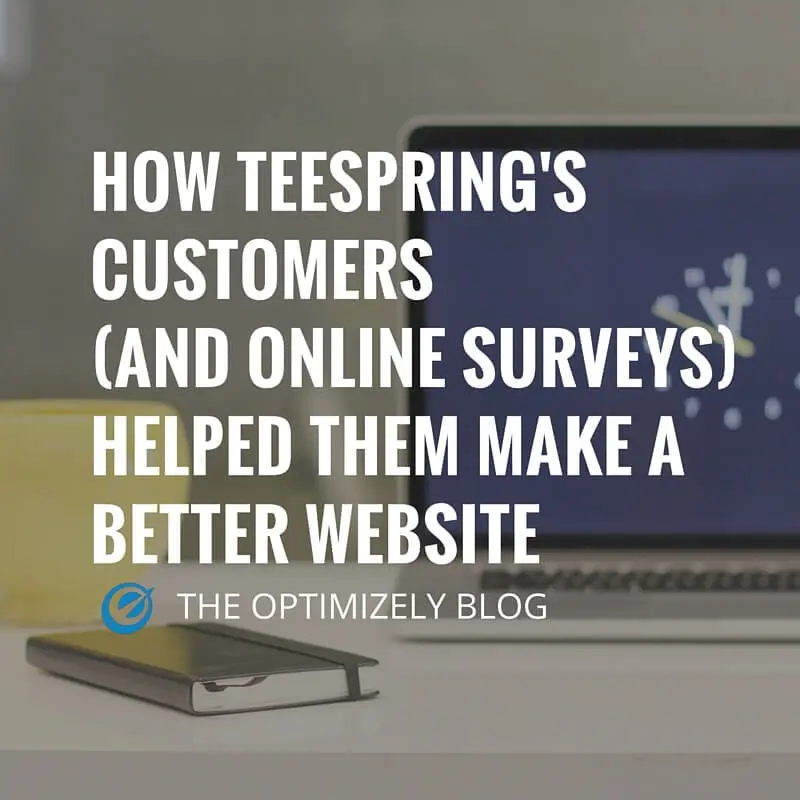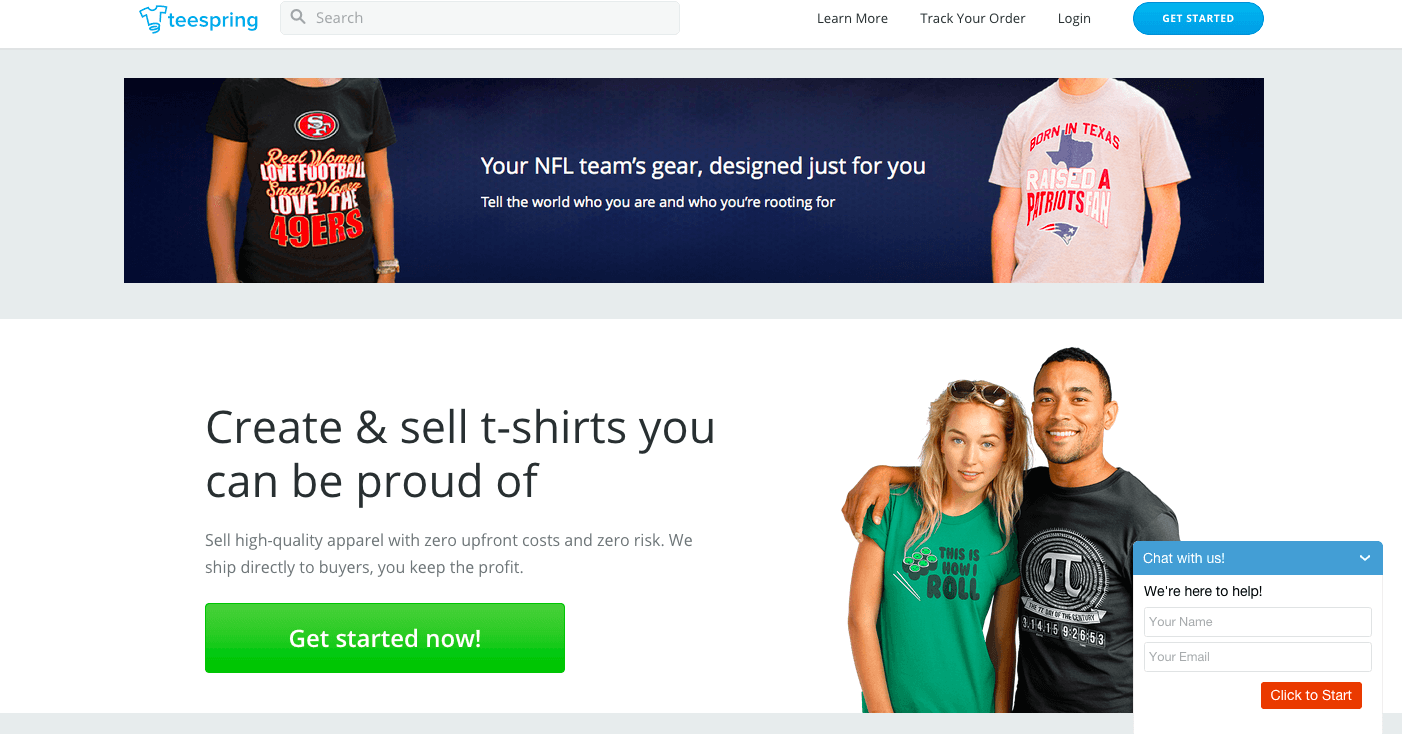How Online Surveys Helped Teespring Increase Conversion by 12.7%
Online survey tools are essential for collecting qualitative feedback from your visitors and users, coloring in the full picture of what you know about their behavior from website analytics. To determine whether you’re addressing their pain points, test changes to your checkout funnel informed by online survey feedback. Learn how Teespring diligently captured customer feedback to uncover a double-digit conversion increase from a straightforward change.

Shana Rusonis

How many times have you reached the end of an online checkout process, and waited with bated breath to find out whether your credit card processed successfully?
Now, raise your hand if you’ve ever been worried that the order didn’t complete, never saw a confirmation email or shipping information, or had to follow up with your credit card company to check for a duplicate payment.
Trading our personal payment information over in exchange for products we want to purchase is something that people do every day without much thought, but definitely notice when something goes wrong. To be able to provide your customers with great digital experiences, it’s essential to make sure that you have a strong understanding of your customers’ concerns and points of friction in your e-commerce platform.
Online survey tools are essential for collecting qualitative feedback from your visitors and users, coloring in the full picture of what you know about their behavior from website analytics. To determine whether you’re addressing their pain points, test changes to your checkout funnel informed by online survey feedback. You’ll be able to determine just how much value addressing those pain points will drive for your business.
In this post, we’ll show how online survey tools helped Teespring, an e-commerce company that allows users to create and buy printed apparel, to improve conversion rates in their checkout funnel, and how you can too.
Leveraging Customer Feedback for E-Commerce Conversion Rate Optimization
The e-commerce industry has become more competitive. At Opticon 2015, we met Jesse Avshalomov, Director of Growth and Product at Teespring, who explains:

Jesse Avshalomov, Director of Growth and Product, Teespring
- The low-hanging fruit is just not present for testing anymore. Checkout funnels and digital shopping carts have existed since the birth of the commercial internet—the user experience of an e-commerce site hasn’t really evolved in the past couple of decades.
- Benchmark conversion rates on e-commerce sites are (comparatively) low. Any stats-savvy tester knows that a low conversion count translates into larger amounts of traffic required to determine an effect.
To find breakthrough success with your e-commerce website or mobile app, you’re going to need some more creative ideas, and you’re going to need to AB test rigorously to measure your progress. The key strategy for increasing your A/B testing success rate: use online survey tools to inform your experiment hypotheses.
“Your best test is a data-driven test,” says Jesse, “and you’ll win some and you’ll lose more. As long as you have a user-behavior based hypothesis, you will learn every time.”
An informed hypothesis also guarantees that your experiment results will generate customer insights regardless of the outcome. Consider, when running your next test, what you’ll learn in the event of a winning variation and in the case of a draw or losing variation.
Online Survey Tools Combat Proximity Blindness
Why are online surveys such an essential method of generating A/B test ideas? Because it’s likely and your team probably have proximity blindness—you’re too close to the experience, and can’t see where your customers are running into points of friction, or need reassurance and trust-building nudges.
At Teespring, Jesse and the growth team set about collecting customer feedback to inform their testing roadmap. “We wanted to learn about where the friction was in our platform—not only for testing; we also just wanted to know.”
They used the following online survey tools to collect direct customer feedback about the experience of shopping for apparel on Teespring:
- Qualitative on-page surveys with Qualaroo
- Ad hoc user surveys with SurveyMonkey
Of course, there are many other excellent online survey tools available, and you can also collect plenty of qualitative visitor and user data through methods like user testing, heat map tools, support ticket and live chat feedback in addition to online surveys.
When kicking off an online customer survey, we recommend taking time to craft excellent questions: Hiten Shah shares his qualitative questions that lead to great A/B tests.
Now that Jesse and the Teespring team had this data, it was time to categorize it and take action on it with optimization.
Optimizing for Customer Trust at Every Step
Although e-commerce is a fundamental part of the commercial internet, there’s still the fundamental premise of asking a customer to hand over their credit card information in order to purchase. Understandably, customers give a lot of thought to how their dollars are spent and what will happen to their personal data. How do you optimize for trust?
At Teespring, Jesse and his team honed in on trust as a potential area for improvement. Their e-commerce platform is somewhat unconventional, and allows customers to both create and purchase t-shirts for various causes, campaigns, and organizations.

TeeSpring’s homepage features a live chat option, an ideal method for collecting customer feedback.
Customers either create a t-shirt design and set up an order, or join an existing order. There is an order goal, which determines the cost of each individual t-shirt. If the order minimum isn’t reached, the shirts are never printed and customers are never charged.
Interesting premise? Absolutely. But this unconventional model requires an additional layer of customer understanding in order to provide the most optimized experience.
When conducting user surveys and collecting feedback, they heard anecdotes like: “Not sure if I should give my credit card information,” and, “Not sure if I’ll get my shirt.”
The second feedback point raised red flags. The team realized that their innovative model—only shipping shirts once reaching a minimum order size—was creating anxiety with so of their potential customers. Many visitors were standoffish about placing an order because they thought they might be charged, even if their shirt was never made.
To counter this problem, the Teespring team ran a subtle test with a not-so-subtle result.
Changing the language below the CTA on the product page to resulted in a whopping 12.7% conversion increase.
Don’t undersell the importance of establishing credibility and trust with your customers at every turn; follow other e-commerce best practices around social proof, security badges, and additional copy to assure your customers that their information is safe. And, of course, make sure that you’re getting direct customer feedback whenever possible to understand how you can improve their online shopping experience.
Looking for more resources to help incorporate online survey tools into your testing and optimization process? Check out these resources:
